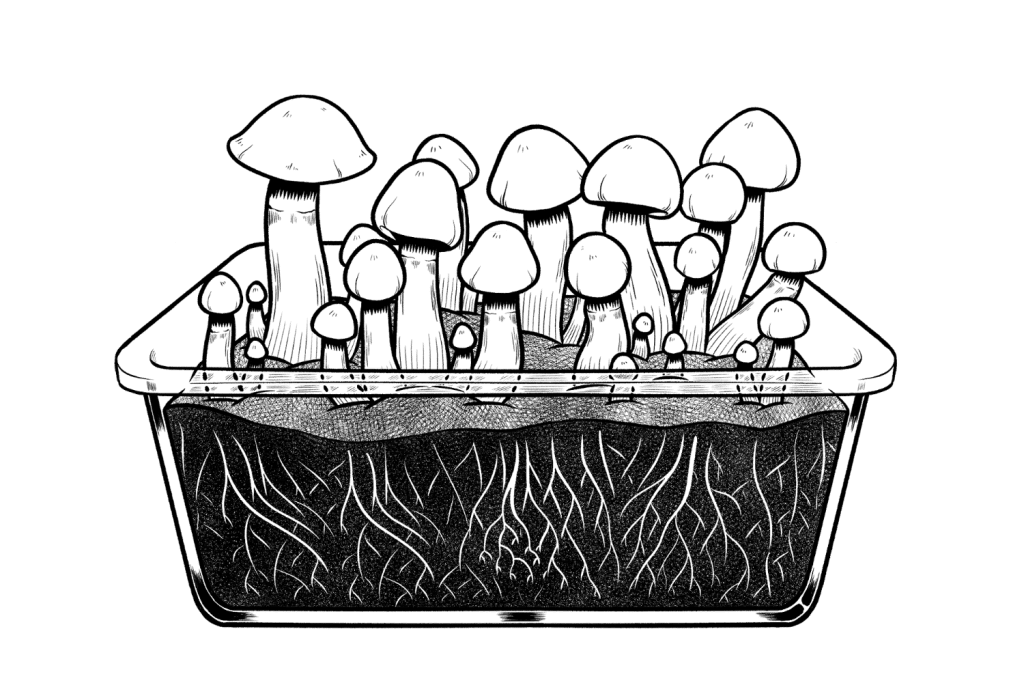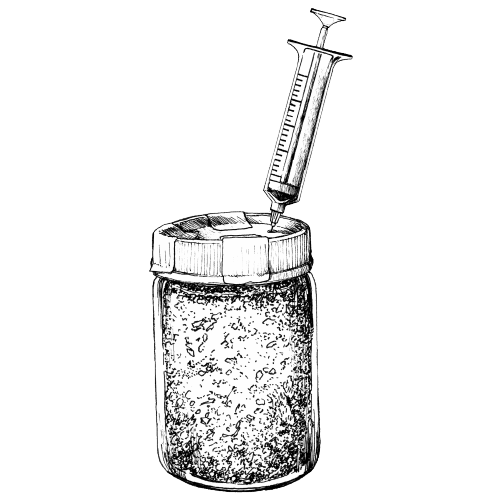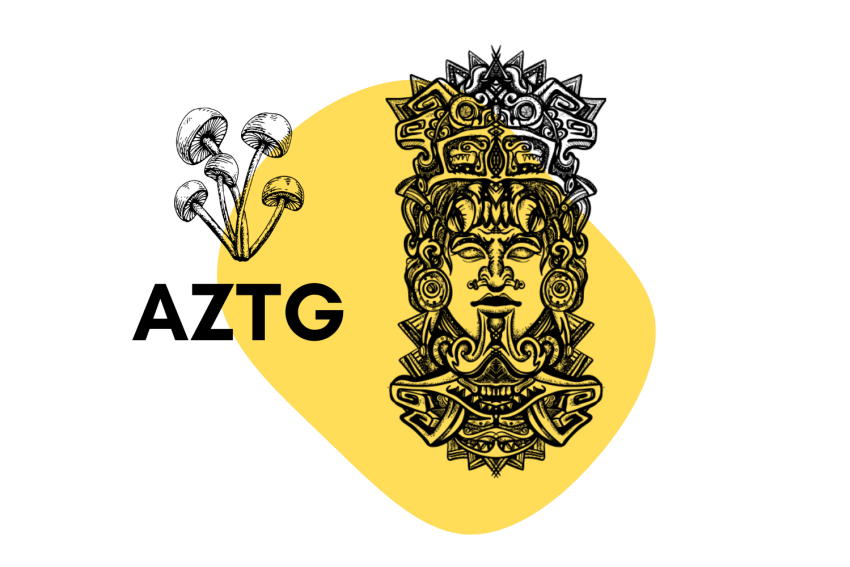No products in the cart.
The Aztecs were known for their use of hallucinogenic fungi — archeologists have uncovered numerous depictions of mushrooms positioned as some form of sacrament around ancient burial sites in Mexico and Central America.
While pre-colonial civilizations most definitely did not use the strain sold as Aztec God today, the name is fitting due to the notable hallucinogenic profile of this Psilocybe cubensis strain (average for Psilocybe cubensis).
We can’t promise you’ll come face to face with some form of ancient Aztec entity when taking these shrooms — but we can’t promise you won’t either.
These cubes come from Central America and Southern Mexico — although their history is somewhat cloudy and hotly debated.
Many ancient civilizations throughout Central America consumed magic mushrooms for religious and spiritual purposes. It’s most likely the ancient shrooms these cultures consumed belonged to a different species entirely — either Psilocybe aztecorum or Psilocybe caerulescens.
In any case, the strain we have today referred to as Aztec God earned its epic name. These shrooms are known to contain high concentrations of psilocybin and lower concentrations of psilocin. These alkaloids are the active ingredients in all species of magic mushrooms (along with the related compound and baeocystin).
Psilocybe Aztecorum Magiska Svampar Specs
| Potency | Average 🍄 |
| Cultivation | Intermediate |
| Species | Psilocybe cubensis |
| Substrate Recommendation | Manure or Coconut Coir |
| Cost | $ |
| Sold By | Sporeslab, Mushly, Spore Buddies |
History of Aztecorum Magic Mushrooms
As the name suggests, Aztec God shrooms were isolated from wild shrooms growing in Central America, specifically in Paso de Cortes in Mexico, in the mountains just south of Mexico City. The first mention of this strain comes from Roger Heim. Heim, a French mycologist, discovered and isolated the strain in 1956 from the Popocatepetl mountains in Mexico.
There is some evidence — mostly in cave paintings, statues, and exploration reports from European explorers — ancient civilizations and more modern ones for religious and spiritual purposes used that magic mushrooms. Specifically, Bernardino de Sahagun, an explorer from Spain, made reference to “teonanacatl,” or the “flesh of the gods.” These references and statues discovered in Mexico seem to confirm that magic mushrooms were a rather important part of Central American culture for hundreds, if not thousands of years.
It’s improbable that today’s Aztec God strain is related to the wild strains used by these civilizations. However, strains constantly change in the wild, and many can proliferate in the same geographical area.
That said, the Aztec God strain is a favorite among shroom users looking for a deeply introspective and spiritual experience. It has relatively high levels of psilocybin and produces a rather intense trip that leaves the user feeling connected to the world around them.
Aztecorum Magic Mushrooms Potency & Psilocybin Content
The Aztec God strain is average in terms of potency — somewhere around 0.50–0.70% psilocybin and 0.10% – 0.20% psilocin (0.60% – 0.90% total tryptamines).
With that said, it’s notoriously difficult to pinpoint the specific potency of mushroom strains because of how much they’re affected by factors like growing and storage conditions.
Even samples taken from different parts of the same mycelial culture have been found to have widely varying psilocybin levels. Likewise, samples tested of the same strain grown in different conditions can also vary significantly.
It’s important to take the potency recommendations of mushroom strains with a grain of salt.
One of the early specimens of the Aztec God strain was noted to have a much lower potency than mentioned above — just 0.20% psilocybin. This reading was taken by Heim and Hoffman, the two men who originally isolated the strain, but it was reportedly taken on an old specimen.
We often turn to the results from Oakland Hyphae’s Psilocybin Cup for more accurate and more recent psilocybin content readings. However, the Aztec God strain is relatively uncommon, and there has not yet been any entries with this particular strain.
Where to Buy Aztec God Shroom Spores
Unfortunately, Aztec God shrooms aren’t nearly as popular as many other strains, so spore syringes or prints can be hard to find. However, a few places sell these spores for those looking to cultivate this ancient strain.
If you live in the United States, your best bets are Sporeslab, Mushy, and Spore Buddies. At the time of writing, all three of these suppliers had Aztec God spores in stock. You can also check Ralphsters Spores, although this strain isn’t always carried.
If you live in Canada, you can check out Spore Door and Sporeslab. However, as of this writing, neither online shop had Aztec God spores in stock.
PsiloLab in the Netherlands is a great source for Aztec God shroom spores in Europe, as they are commonly in stock there. For updated availability, you can also check out Viking Spore and The Magic Mushrooms Shop.
Related: How & Where to Buy Magic Mushroom Spores (Legally).
How to Grow Aztec God Shrooms
Most magic mushroom strains are similar in the cultivation process, but the specifics can vary a bit. When it comes to the Aztec God strain, wood is the preferred substrate because this strain originally grew on trees in the mountain ranges of Mexico. Additionally, since these shrooms originally grew at high elevations in the mountains, some people believe they require higher elevations to be cultivated successfully.

However, growing shrooms on wood logs is often more challenging than using other sterilized substrates. Since many people cannot grow at higher elevations, we’ll detail the easier process below that can be done anywhere. You can check out our complete mushroom growing guide for more information.
Step 1: Get Your Substrate Ready
First, you need to mix your substrate. A good alternative to wood is rye grain or brown rice flour. Mix 2 parts of either of these with 2 parts vermiculite and 1 part water. Fill a mason jar up to about ¾” below the rim with this mixture, then top off with dry vermiculite.
Step 2: Sterilize Your Substrate
Next, cover the mason jar with tin foil and place it in a pressure cooker or Instant Pot. Keep it above 121 degrees F for at least 30 minutes.
Step 3: Inoculation
Next, sterilize the room where you plan to carry out inoculation. This step is crucial to get right, as it is the most likely point where your shroom culture can become contaminated. Introduce your shroom spores to your substrate.

Step 4: Incubation & Colonization
Keep the sealed mason jar between 70 and 80 degrees, above 85% humidity, and in the dark. Maintain these parameters until the entire substrate is covered in white mycelium.
Step 5: Fruiting
Once the mycelium has overtaken the substrate, you can introduce it to your fruiting chamber. Keep this above 85% humidity as well and between 50 and 65 degrees F. Your shrooms should start to produce fruiting bodies in just a few days.
Step 6: Harvest
When the veil on the bottom of the shrooms breaks, it’s time to harvest. You should be able to get 2 to 4 flushes out of your Aztec God shrooms, but keep an eye out for mold, which is a clear sign that you need to ditch everything. If you find that you’re stuck between flushes, you can introduce your shrooms to an ice bath for 20 minutes or so before returning them to the fruiting chamber.













Reviews
There are no reviews yet.